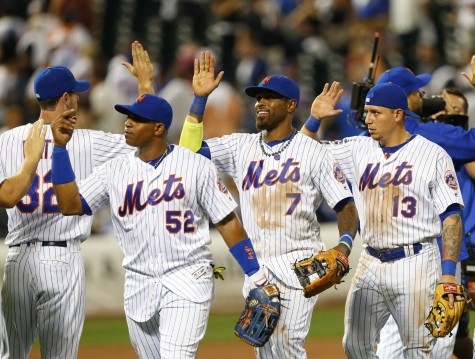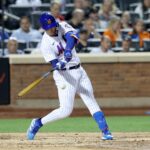
Dan Szymborski was kind enough to answer a few questions for me about the recently released 2017 ZiPs Projections for the New York Mets, which you can view on FanGraphs.
Joe D. – One of the first things that jumped out at me when I sifted through the recently released Mets projections was the very optimistic view on Michael Conforto, and then of course the sobering reality hits me that he’ll probably never see those 558 plate appearances. So sad. Still, what did ZiPS like about Conforto after such a disappointing 2016 season?
Dan – Well, Conforto has a solid history (and hit very well in 2015) and absolutely torched the minors. Yeah, you have to take the air out of the PCL stats, but still, he hit 422/483/727 in nearly 150 PA down there. Seemed like the classic case of panicking about a player’s slump and sending him down so that the Triple-A team gets the benefit when he’s playing well again. Conforto needs to learn to work through his slumps in the majors, not get demoted every time the Mets get worried.
Joe D. – Which brings me to Jay Bruce… You have like a gazillion Mets ahead of him in zWAR and I don’t know if I should laugh or cry. The only people I ever talk to are Mets fans, which explains why I suffer from over a dozen different psychological disorders. So let me ask you as one who is on the outside looking in… Did we totally botch this Jay Bruce situation from day one? Did we make a bad situation worse by picking up that $13 million option? What’s your take on all of this?
Dan – I would’ve turned down the option, given that Bruce really solves absolutely nothing the Mets are missing. He can’t play centerfield and he’s not really that amazing a hitter – his 112 OPS+ in 2016, his best number since 2013, wasn’t even average for a corner outfielder. Bruce should be a DH for the Yankees or something, but if the Yankees weren’t going to trade something of value for him — they weren’t — no reason to have him on the roster. The Cult of RBI may be much diminished, but it still pops up occasionally.
Joe D. – On your player comps, how does that work? For example, you comp’d Noah Syndergaard to Dwight Gooden, is that a career comp or are you saying that in 2017 he’ll have an average Gooden type season? Or is it a peak Gooden season? (Oh please, let it be this!)
Dan – They’re recent year comps, meaning that once the weighted stats from previous years have been normalized and combined with his characteristics, Noah Syndergaard’s baseline “current ability” from recent years is closest to Dwight Gooden’s at a similar point in his career. The comps are backwards looking, it doesn’t mean he’s predicted necessarily to pitch like Dwight Gooden in the upcoming season. For example, occasionally, a young 2B with interesting power and a meh OBP gets Robinson Cano as a top comp and people go insane about that. But it’s important to remember that most hitters like Robinson Cano prior to his explosion, don’t become Robinson Cano.
Joe D. – We did our own analysis comparing the Mets starting rotation to the Nationals and we seem to think it’s a lot closer than what the ZiPS projections suggest. Honestly. if the Mets starting rotation stays healthy (a big if, I know) I think they’re significantly better than the Nationals. But seriously, why the big gap? Sure, they have Max Scherzer, but didn’t Syndergaard outproduce him in WAR last season?
Dan – The gap is really mostly due to the lesser projected IP in ZiPS for the Mets pitchers, so I wouldn’t worry about there being much of a gap.
Joe D. – More so than in any other sport, the evolution of advanced data in baseball has been very public. Pitch f/x is available for free online, as are many advanced stats that teams use too. Do you see that continuing?
Dan – MLB is a very data-driven sport, simply because the nature of baseball, events mainly being discrete and easy to suss out of the games, makes it the major sport that lends itself best to data analysis. We’ll continue to see this stuff, there’s an interest for it in the public and for teams, while they won’t be happy to admit it, they still want to see what people outside of their organizational structures are doing with data, so this kind of data always trickles out.
Joe D. – What’s your take on early-career extensions for promising young players? Are they too risky? Should the Mets have locked up their young starting pitchers early?
Dan – Always depends on the player and the specific situation. Generally speaking, teams should be locking up their best players while they have the leverage.
Joe D. – Several reports are confirming that the Mets and Neil Walker are discussing a potential three-year extension deal. Walker says his back feels great after surgery, but who really knows. The Mets are already on the hook for $17.2 million after he accepted the QO. Locking Walker up, Boom or Bust?
Dan – It would depend on the contract in question of course, there’s a price in a three-year extension at which I’d happily welcome back Walker and a price at which I’d thank him for his service and tell him we’re going to look at other options. I’d do a three-year extension in the neighborhood of $50 million, but not willing to go much higher than that.
Joe D. – Dan, thanks so much for taking the time to answer a few questions for our site. You can follow Dan on Twitter at @DSzymborski.















